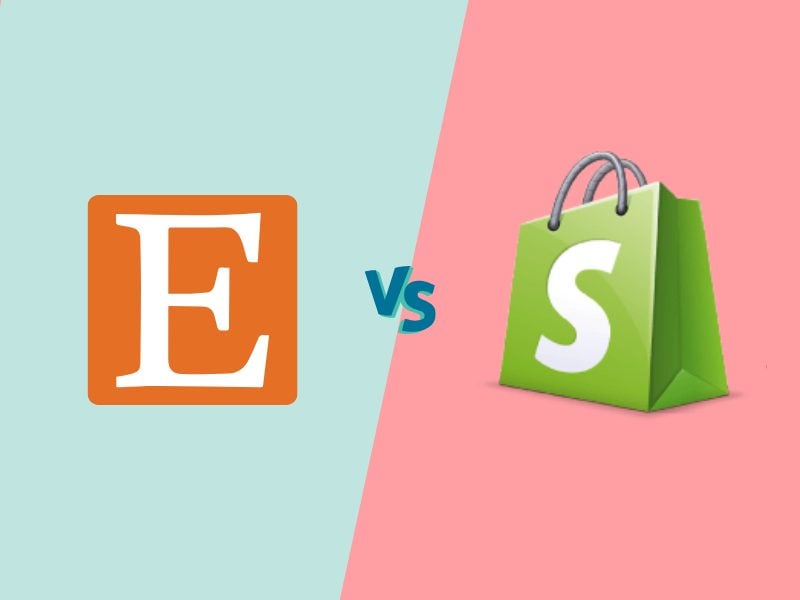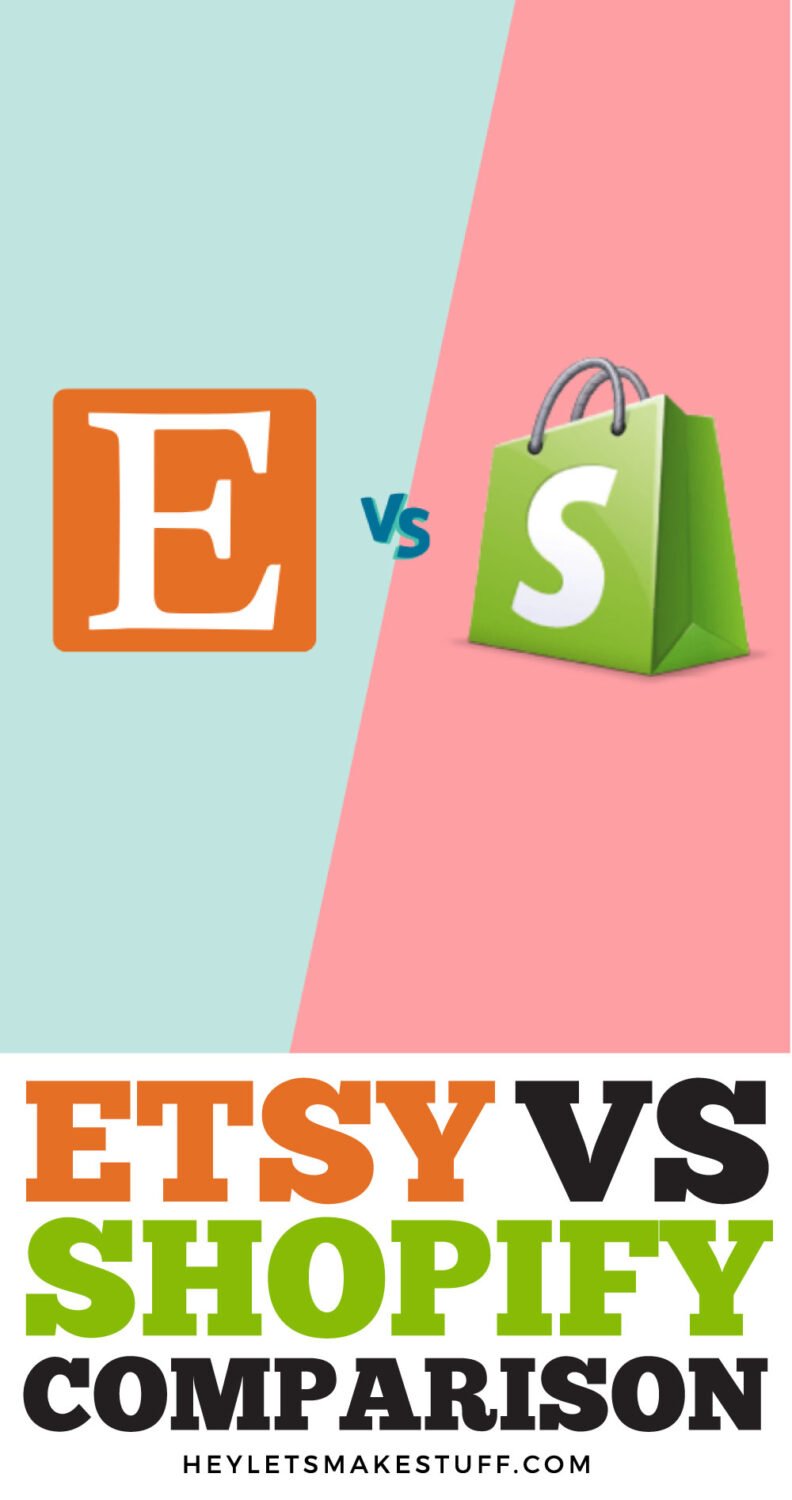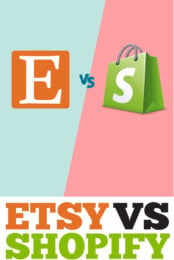If you want to sell your crafts online, there are a few options, but Etsy vs. Shopify is the number one question I get! Here are the pros and cons of each so you can make the right choice for your business.

Let’s talk online selling platforms! While there are more options beyond Etsy and Shopify (including Amazon marketplace, Facebook groups, Instagram and TikTok shopping, Ecwid, etc.), those two are generally where most new craft businesses start.
While we are comparing Etsy and Shopify, it’s not really an apples to apples comparison. They are similar, but they aren’t the same.
Think about Etsy like a Target. There are lots of things for sale from lots of brands, but you have a space on the shelf in your category. Customers will already be looking around in the store and if your product matches their needs, they can easily purchase.
Shopify is more like building your own boutique. Everything you own in the shop is yours and you get to decide how it’s presented and sold. You have way more control than you do on Etsy. But you don’t already have the built-in audience that’s headed to Target for other things. You need to find ways to bring your shoppers to you.
So the question is…do you want to sell on Etsy and take advantage of their built-in traffic and search engine? Or do you want to create a site from scratch with more personalization but you’ll have to drive the customers there yourself?
Neither platform is perfect, but there is probably one that is better than the other for your particular needs. In today’s post, we’re going to look at the pros and cons of Etsy and Shopify so you can figure out what’s right for the stage and needs of your own business.
Watch the Video
Want to get a video overview Etsy vs Shopify? Just hit play below! Or keep reading for a written comparison.
Audience Reach vs. Brand Control
Number one is what I already mentioned—a built in audience vs. building your own brand.
Etsy has millions of shoppers searching specifically for handmade goods. But you’re also directly competing with other shops. So if you sell crocheted hats for babies, you’re going to be competing with all of the other Etsy sellers who also sell crocheted hats for babies. The audience is there, so you have to make yourself stand out. The hard part is that you can’t control Etsy’s branding or listings. There’s very little control when it comes to customizing things on Etsy to your brand.
Shopify, on the other hand, allows you full control over your branding, design, and the entire customer experience. There are thousands of templates for shops so you can find one and customize it exactly how you want it. This might be a challenge for people with little to no design experience! Templates can help, but it is definitely something that can take a lot of time. And with Shopify, you have to drive your own traffic to your listings, which can be particularly challenging for new businesses.
Verdict: If you already have a social or email following, Shopify may allow for better long-term growth and flexibility. But if you’re just starting out, you’d probably benefit more from Etsy’s built-in audience.
Fees and Hidden Costs
Choosing a platform also means that you are going to be paying some fees no matter what. These fees are inevitable, because these platforms are helping you build your business and they need money to run their platforms.
A lot of people like to complain about Etsy’s fees, which is understandable. If you’re sell a product, you’ll pay a listing fee, a transaction/payment processing fee, plus a percentage that Etsy keeps. If you offer free shipping (which Etsy encourages you do on orders over $35), you may also be paying for shipping out of pocket. All of this can be a real bummer when it comes to your final profit on a product.
Shopify has its own fees, however, including the monthly payment to use the platform, transaction/payment processing fees, and add-ons for additional features like apps that add reviews. You most likely will also want to use a custom domain name (like mine is www.chapterandcraft.com) and that will cost you as well.
Verdict: It’s really you’ll need to calculate all of the fees for yourself, taking in all of the factors. No matter what, you’re going to be paying something. It’s just up to you whether or not the things you are paying for are worth it.
SEO and Marketing
One of the best things about Etsy is that it also has a robust search engine that can help potential customers find your products, if you can get your listings right (more on this in an upcoming post!). There is limited control over SEO since it’s limited primarily to titles, listing data, and tags, but it’s possible to make Etsy’s search engine work for you. You can also drive traffic through Etsy ads, but you have little control over targeting and reach. One other thing to know is that Etsy is always changing their algorithm, which can affect your shop’s visibility in search rankings.
With Shopify, however, you can build out a long-term SEO strategy using programs like Google Analytics. You can also target specific customers using Google and Facebook. That being said, this is often very overwhelming for new (and even seasoned) crafters who tend to be more creative and less analytical. And Google also loves to do the algorithm switch, which means what ranks today may not rank tomorrow.
Verdict: Unless you have a background in SEO or you want to spend a lot of time in the weeds getting to know it, Etsy is probably a better choice for crafters who want the built in search engine.
Managing Product Listings
When it comes to your actual products, Etsy has a streamlined listing process but there’s very little customization available. You’re always going to get Etsy’s layout and structure. Etsy can also be limiting when it comes to creating variations and bundles, as well as the way you organize your shop. Products can only be in one category, which is frustrating when things might fall easily into two categories, like “tumblers” and “Halloween.” This is frustrating to many users (including me!).
Shopify, on the other hand, gives you full control over your product pages. You can add variants, upsells, bundles, categories, and more. Some of these may require an added app (which are often paid), but having that control makes it a lot easier to customize your show and products exactly how you want.
Verdict: If you find yourself really getting frustrated with the limitation of Etsy’s product listings, it might be time to look at Shopify.
Ownership
One thing that sellers don’t often think about is data ownership. You will always own your products, but with Etsy, they control your shop and the customer relationship. You may have your shop taken down without even finding out why. And you don’t have direct access to their email addresses beyond using the platform’s messaging. There are ways to get people on your email list, but it’s not as easy.
With Shopify, you have more access to your customer’s data, including email addresses for building your email list as well as retargeting through marketing campaigns. You will still need permission to email your customers (often this is just a checkbox on the checkout page), but it’s much easier to connect with your customers on Shopify than it is on Etsy.
Verdict: As a small business, owning your customer data can help build long-term relationships with your audience, something Etsy doesn’t give you control over.
Scaling Your Business
As you can see from many of the other points I’ve made here in this post, Etsy is idea for new crafter businesses, but it can become more difficult to scale. Growing your email list and connecting with your customers outside of Etsy is just more difficult.
Shopify has better tools for scaling. Some of the biggest ecommerce sites out there are built on Shopify, and there are endless apps that you can add to your shop as your grow.
Verdict: It’s probably easiest to start with Etsy, but if you’re seeing a ton of growth, then it might be time to look at opening a Shopify store, especially if you want to get into things that Etsy can’t do as well, like print on demand or wholesale fulfillment.
Which One is Right for You?
Overall, I generally recommend that most crafters start with an Etsy shop, especially if they don’t already have an audience on social or through email. Etsy makes it pretty darn simple to get your listings added to your shop and start driving their already-existing customer base to your shop. Yes there are a lot of limitations, but when you’re just getting started, often those limitations help keep you from spending a ton of extra money where you don’t need it yet.
If you are seeing success on Etsy and want to start to grow your own business, you can set up a simple Shopify shop. You’ll see right away that it’s much more flexible and customizable, but it’s also much harder to drive traffic to your products.
In a future post, we’ll talk more about strategies to get people from Etsy onto your email list and social so that you can more easily drive traffic to either type of shop!
I’d love to hear your experiences with Etsy and Shopify down in the comments! If you want to join my email list for Small Business Saturday, you can do that here! And if you want to see how I’m emailing my own email list about my small business (and maybe buy some cool bookish stuff!), you can do that here!




Comments & Reviews
Alaia Indiko says
Great breakdown of Etsy and Shopify! I’m curious about how each platform handles international shipping. Do you have any insights on managing shipping logistics for global customers, especially for someone just starting out?
Also, for anyone considering expanding their craft business internationally, you might find this site interesting: https://world-prices.com. It has some info, though it’s hard to say how current the data is.
Thanks again for the detailed comparison!
Crystal Summers says
Hi Alaia,
Thank you! Glad you found it helpful. Each site has backend shipping profiles that you can set up and choose to include/not include international shipping. Cori doesn’t currently have international shipping on her site, so we don’t have any personal tips on that at the moment. Each website, as well as the shipping carriers will provide more details, though!
Happy crafting,
Crystal, HLMS Community Manager
Sigurður Einarsson says
Great breakdown of the pros and cons for choosing between Etsy and Shopify for a craft business. It’s really helpful to see them compared like this, especially for someone new to online selling. I am curious, how difficult is it to actually drive traffic to a Shopify store if you start from scratch? I’ve been weighing the idea of having more control over my shop but the thought of building an audience feels overwhelming. Any tips on effective ways to get started?
By the way, if anyone’s venturing into international markets, you might want to check out https://world-prices.com to get a sense of costs elsewhere—though not sure how up-to-date all that info is!
Crystal Summers says
Hi Sigurður,
Yes, driving traffic to your shopify will be a bit tougher, but you can start with Etsy and encourage people to sign up for your email list or send them a coupon to shop on your website (via message or in their package) after they place an order. Many small businesses use Etsy almost as lead gen to get people to their own site eventually. You have to find what works best for you, but maybe it’s not an either or for you, but rather both? At least to start! Hope this helps!
Happy crafting,
Crystal, HLMS Community Manager